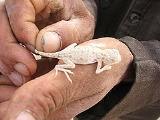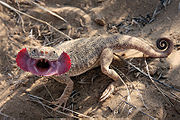
Phrynocephalus
Encyclopedia
Phrynocephalus, commonly called Toadhead Agamas or Toad-headed Agama, includes more than 45 species of small and medium sized agamid
lizards that inhabit open arid and semiarid environments of Asia and Eastern Europe. Systematics of this genus is very complicated. And there are a lot of controversial points of view about unclear phylogeny of this group. All representatives of this genus have been adopted so called "sit and wait" hunting strategy and they actively use visual orientation when watching for food. In general, the ecological niche and role of Phrynocephalus species in lizard communities of arid environments of Asia are poorly studied, but seem to be similar to that of Phrynosoma, Cophosaurus, Holbrookia
, Uta
, Sceloporus in New World, as well as Moloch
in Australia.
Biogeography
The toad-headed lizards of genus Phrynocephalus are distributed from northwestern China to Turkey and are one of the major components of the central Asian desert fauna. To date, published morphological and molecular phylogenetic hypotheses of Phrynocephalus are only partially congruent, and the relationships within the genus are still far from clear. We re-analyzed published mitochondrial gene sequence data (12S, 16S, cyt b, ND4-tRNALeu) by employing partition-specific modeling in a combined DNA analysis to clarify existing gaps in the phylogeny of Chinese Phrynocephalus. Using this phylogenetic framework, we inferred the genus’ historical biogeography by using weighted ancestral-area analysis and dispersal-vicariance analysis in combination with a Bayesian relaxed molecular-clock approach and paleogeographical data. The partitioned Bayesian analyses support the monophyly of Phrynocephalus and its sister-group relationship with Laudakia. An earlier finding demonstrating the monophyly of the viviparous group is corroborated. However, our hypothesis of internal relationships of the oviparous group differs from a previous hypothesis as our results do not support monophyly of the oviparous taxa. Instead, the viviparous taxa form a clade with many oviparous taxa exclusive of P. helioscopus and P. mystaceus. Our results also suggest that: (1) P. putjatia is a valid species, comprising populations from Guide, Qinghai Province and Tianzhu, Gansu Province; (2) P. hongyuanensis is not a valid species, synonymized instead with P. vlangalii; (3) P. zetangensis is not a valid species and should be included in P. theobaldi; (4) the population occurring in Kuytun, Xinjiang Uygur Autonomous Region is recognized as P. guttatus instead of P. versicolor; and (5) the Lanzhou population of P. frontalis is part of P. przewalskii. Congruent with previous hypotheses, the uplift of the Tibetan Plateau played a fundamental role in the diversification of Phrynocephalus. An evolutionary scenario combining aspects of vicariance and dispersal is necessary to explain the distribution of Phrynocephalus. Bayesian divergence-time estimation suggests that Phrynocephalus originated at the Middle-Late Miocene boundary (15.16-10.4Ma), and diversified from Late Miocene to Pleistocene from a center of origin in Central Asia, Tarim Basin, and Junggar Basin temperate desert, followed by several rapid speciation events in a relatively short time

Agamidae
Agamids, lizards of the family Agamidae, include more than 300 species in Africa, Asia, Australia, and a few in Southern Europe. Many species are commonly called dragons or dragon lizards. Phylogenetically they may be sister to the Iguanidae, and have a similar appearance. Agamids usually have...
lizards that inhabit open arid and semiarid environments of Asia and Eastern Europe. Systematics of this genus is very complicated. And there are a lot of controversial points of view about unclear phylogeny of this group. All representatives of this genus have been adopted so called "sit and wait" hunting strategy and they actively use visual orientation when watching for food. In general, the ecological niche and role of Phrynocephalus species in lizard communities of arid environments of Asia are poorly studied, but seem to be similar to that of Phrynosoma, Cophosaurus, Holbrookia
Holbrookia
Holbrookia is a genus of earless lizards, known commonly as the lesser earless lizards, which contains three recognized species that are found throughout the southwestern and central United States, and northern Mexico. They are characterized by having no external ear openings, presumably to prevent...
, Uta
Side-blotched lizard
Side-blotched lizards are lizards of the genus Uta. They are some of the most abundant and commonly observed lizards in the deserts of western North America. They commonly grow to six inches including the tail, with the males normally being the larger sex. Males often have bright throat colors....
, Sceloporus in New World, as well as Moloch
Moloch
Moloch — also rendered as Molech, Molekh, Molok, Molek, Molock, or Moloc — is the name of an ancient Semitic god...
in Australia.
Biogeography
The toad-headed lizards of genus Phrynocephalus are distributed from northwestern China to Turkey and are one of the major components of the central Asian desert fauna. To date, published morphological and molecular phylogenetic hypotheses of Phrynocephalus are only partially congruent, and the relationships within the genus are still far from clear. We re-analyzed published mitochondrial gene sequence data (12S, 16S, cyt b, ND4-tRNALeu) by employing partition-specific modeling in a combined DNA analysis to clarify existing gaps in the phylogeny of Chinese Phrynocephalus. Using this phylogenetic framework, we inferred the genus’ historical biogeography by using weighted ancestral-area analysis and dispersal-vicariance analysis in combination with a Bayesian relaxed molecular-clock approach and paleogeographical data. The partitioned Bayesian analyses support the monophyly of Phrynocephalus and its sister-group relationship with Laudakia. An earlier finding demonstrating the monophyly of the viviparous group is corroborated. However, our hypothesis of internal relationships of the oviparous group differs from a previous hypothesis as our results do not support monophyly of the oviparous taxa. Instead, the viviparous taxa form a clade with many oviparous taxa exclusive of P. helioscopus and P. mystaceus. Our results also suggest that: (1) P. putjatia is a valid species, comprising populations from Guide, Qinghai Province and Tianzhu, Gansu Province; (2) P. hongyuanensis is not a valid species, synonymized instead with P. vlangalii; (3) P. zetangensis is not a valid species and should be included in P. theobaldi; (4) the population occurring in Kuytun, Xinjiang Uygur Autonomous Region is recognized as P. guttatus instead of P. versicolor; and (5) the Lanzhou population of P. frontalis is part of P. przewalskii. Congruent with previous hypotheses, the uplift of the Tibetan Plateau played a fundamental role in the diversification of Phrynocephalus. An evolutionary scenario combining aspects of vicariance and dispersal is necessary to explain the distribution of Phrynocephalus. Bayesian divergence-time estimation suggests that Phrynocephalus originated at the Middle-Late Miocene boundary (15.16-10.4Ma), and diversified from Late Miocene to Pleistocene from a center of origin in Central Asia, Tarim Basin, and Junggar Basin temperate desert, followed by several rapid speciation events in a relatively short time
Species
- Phrynocephalus albolineatus (Zhao, 1979) – White-lined Toadhead Agama
- Phrynocephalus alticolaPhrynocephalus alticolaThe Montane toad-headed agama Phrynocephalus alticola is a species of agamid lizard found in India .-References:* Peters G 1984 Die Krötenkopfagamen Zentralasiens . MITTEILUNGEN AUS DEM ZOOLOGISCHEN MUSEUM IN BERLIN 60: 23-67...
Peters, 1984 – Montane Toad-headed Agama - Phrynocephalus arabicus (Anderson, 1894) – Arabian Toadhead Agama
- Phrynocephalus arcellazzii (Bedriaga, 1909) – Central Asian Toadhead Agama
- Phrynocephalus axillaris (Blanford, 1875)
- Phrynocephalus birulai (Tzarevsk, 1927) – Tsarewsky's Toadhead Agama
- Phrynocephalus clarkorum (Anderson & Leviton, 1967) - Clark's Toad-headed Agama
- Phrynocephalus elegans (Tzarevsk, 1927) – Elegant Toadhead Agama
- Phrynocephalus euptilopusPhrynocephalus euptilopusAlcock's toad-headed agama Phrynocephalus euptilopus is a species of agamid lizard found in Pakistan , Afghanistan and possibly in parts of India.Type locality: Darband , Northern Baluchistan....
(Alcock & Finn, 1897) – Alcock's Toad-headed Agama - Phrynocephalus forsythii (Anderson, 1872) – Forsyth's Toadhead Agama
- Phrynocephalus geckoides (Bedriaga, 1909) – Gecko Toadhead Agama
- Phrynocephalus golubewii (Shenbrot & Semyonov, 1990)
- Phrynocephalus guinanensis (Ji, Wang & Wang, 2009) Zootaxa
- Phrynocephalus guttatus (Gmelin, 1789) – Spotted Toadhead Agama
- Phrynocephalus helioscopus (Pallas, 1773) – Sunwatcher Toadhead Agama
- Phrynocephalus hongyuanensis (Zhao, Jiang & Huang, 1980)
- Phrynocephalus interscapularis (Lichtenstein, 1856) – Lichtenstein's Toadhead Agama
- Phrynocephalus laungwalaensis (Prakash,1980 ) Rajasthan Toad-headed Agama
- Phrynocephalus lidskii (Bedriaga, 1909) – Tibetan Toadhead Agama
- Phrynocephalus luteoguttatusPhrynocephalus luteoguttatusYellow-speckled toad-headed agama Phrynocephalus luteoguttatus is a species of agamid lizard found in Iran, Afghanistan, Pakistan and possibly in India.Type locality: between Nushki and Helmand ....
(Boulenger, 1887) – Yellow-speckled Toad-headed Agama - Phrynocephalus maculatus (Anderson, 1872) – Blacktail Toadhead Agama
- Phrynocephalus melanurus (Eichwald, 1831) – Saissan Toad-headed Agama
- Phrynocephalus moltschanowi (Nikolsky, 1913)
- Phrynocephalus mystaceusPhrynocephalus mystaceusPhrynocephalus mystaceus is a species of agamid lizard found in Iran, North Afghanistan, Eastern Caucasus, Kazakhstan and possibly in south of Astrakhan Oblast. Could reach up to 24 centimetres in length....
(Pallas, 1776) – Secret Toadhead Agama

- Phrynocephalus nasatus (Golubev & Dunayev, 1995)
- Phrynocephalus ornatus (Boulenger, 1887) – Ornate Toadhead Agama
- Phrynocephalus parvulus (Tzarevsky, 1927) – Slight Toadhead Agama
- Phrynocephalus parvus (Bedriaga, 1909)
- Phrynocephalus persicusPhrynocephalus persicusThe Persian Toad-headed Agama , also known as Horvath's Toad Headed Agama, is a species of agamid lizards in the Phrynocephalus genus that inhabits central Asia...
(De Filippi, 18630) - Phrynocephalus przewalskii (Strauch, 1876) – Przewalski's Toadhead Agama
- Phrynocephalus pylzowi (Bedriaga, 1909) – Pylzow's Toadhead Agama
- Phrynocephalus raddei (Boettger, 1888)
- Phrynocephalus reticulatusPhrynocephalus reticulatusReticulated toad-headed agama Phrynocephalus reticulatus is a species of agamid lizard found in Central Asia and West Asia.-Distribution:N Afghanistan, S Kazakhstan, W Uzbekistan, Turkmenistan and N Pakistan ....
(Eichwald, 1831) – Reticulated Toad-headed Agama - Phrynocephalus roborowskii (Bedriaga, 1909) – Roborowski's Toadhead Agama
- Phrynocephalus rossikowi (Nikolsky, 1898) – Uzbekistan Toadhead Agama
- Phrynocephalus salenskyi (Bedriaga, 1909) – Salensky's Toadhead Agama
- Phrynocephalus scutellatus (Olivier, 1807) – Gray Toadhead Agama
- Phrynocephalus sogdianus (Chernov, 1959) – Tadjikistan Toadhead Agama
- Phrynocephalus steindachneri (Bedriaga, 1909) – Steindachner's Toadhead Agama
- Phrynocephalus strauchi (Nikolsky, 1899) – Strauch's Toadhead Agama
- Phrynocephalus theobaldiPhrynocephalus theobaldiTheobald's toad-headed agama, or snow lizard is a species of agama found in eastern Turkestan, India , Nepal and China .Type locality: Lake Chomoriri = Tsho-marari, Rupshu Province, Tibet....
(Blyth, 1963) – Theobald's Toad-headed Agama, Toad Mounted Lizard, Snow Lizard - Phrynocephalus versicolor (Strauch, 1876) – Variegated Toadhead Agama
- Phrynocephalus vlangalii (Strauch, 1876) – Ching Hai Toadhead Agama
- Phrynocephalus zetanensis Wang et al.., 1996

